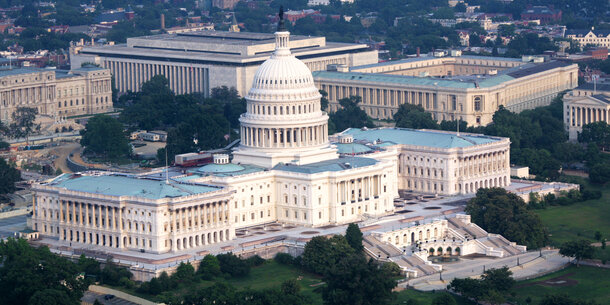The longest U.S. government shutdown in history is over. The 43-day shutdown reminded us just how stuck our government is — and that Congress remains the key to unsticking it.
Congress and the executive branch have long been embroiled in an interbranch power struggle, including fighting over spending powers. The second-longest government shutdown in history, the 21-day budget impasse beginning in late 1995, provides an important example. A balanced budget was a central priority of the Republicans who had retaken control of the House after 40 years in the minority. The Newt Gingrich–led House pushed for spending cuts, which President Bill Clinton vetoed.
One of the key points of contention during the negotiation was whether to rely on projections from the Congressional Budget Office or the White House Office of Management and Budget. Clinton said House Republicans “failed to pass the straightforward legislation necessary to keep the government running without imposing sharp hikes in Medicare premiums,” a statement reminiscent of the recent shutdown. After weeks of back-and-forth with the Clinton administration, Republicans abandoned their quest to balance the budget and acquiesced. The three-week stalemate was a showdown between House leadership from one party and a president from another.
Fights over impoundment — the claim that the president has the power to not spend money that Congress has approved — are also not new. Although impoundment is unconstitutional, President Richard Nixon still withheld more than $50 billion in the early 1970s. Carl Albert, House speaker at the time, wrote, “Take away this power [of the purse], and Congress is nothing more than a debating society. . . . The votes the people cast for their representatives would become meaningless acts. Unchecked by this fundamental legislative power, any President would have the autocratic prerogative to do and spend as he pleases.”
President Trump revived impoundment, describing it at one of his rallies as something that “allows the president to go out and cut things and save a fortune for our country. Things that make no sense.” He paused the work of entire federal agencies, took back funds from New York City after disbursement, and defied Congress by moving to cut $5 billion in foreign aid that Congress had already approved.
This is a dangerous precedent. A supine Congress threatens our constitutional order and our democracy. We know from international examples of democratic backsliding that when weak legislatures cede power to the executive, authoritarian leaders can more easily consolidate power. In Hungary, Viktor Orbán’s Fidesz party changed the Constitution and stripped the legislature of many powers, solidifying the autocrat’s unilateral control. On the other hand, in South Korea after the impeachment of Park Geun-hye, the Korean National Assembly’s investigative authority and oversight were expanded in a series of reforms that strengthened Korean democracy.
As I explain in my forthcoming book, Stuck, rising tides of violence, distortions of money in politics, and technological shifts have undermined Congress’s ability to act over the last 50 years. The book begins immediately after Watergate in 1974, when a class of reformers came to Washington to fix American democracy. It follows three of the largest groups of new members elected to Congress in the past half century — the classes of 1974, 1994, and 2018. Each one was roused by the notions that our politics were broken and the president had overstepped his bounds. The historical survey explains how Congress became so mired in a historical morass that it is no longer coequal with the executive, and posits that its members can no longer perform their roles.
The book also presents a plan for unsticking Congress and restoring its capacity to govern. Campaign finance reform is critical to ensure that members of Congress have time to devote to oversight and legislation instead of spending hours courting donors. Overhauling inefficient internal structures and increasing member resources in a Congress that has 120 times less funding than the executive branch are also crucial steps to grant the legislative branch the independent power necessary to provide a check on the executive. And in a climate where political violence is constricting civic engagement, deterring people from running for or remaining in office, and even swaying how they vote when they fear violence, we must invest in the policy changes needed to keep members safe. The book details these and other policy changes that can get Congress back on track.
Congress is malleable. It moves in cycles. It is shaped and reformed by the people who walk its halls and those who elect them — and vote them out. Now more than ever, we need a strong Congress to stand up to the president and protect our democracy. And we must learn from history to keep not just hoping but pushing for change.



